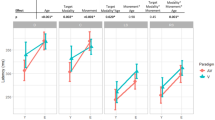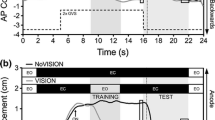Abstract
Attention has been implicated in postural control and other tasks requiring sensory integration. The purpose of this study was to investigate the role of attention in sensory-motor processing of vestibular and combined visual–vestibular information during seated rotations using a dual-task interference approach. We hypothesized that auditory information processing would be influenced by concurrent visual-ocular, vestibulo-ocular, or combined visual-vestibulo-ocular processing. We further hypothesized that the effect would be greater in older subjects. Twenty older subjects (10 women, 10 men, 69.3±3.2 years) and 20 young subjects (10 women, 10 men, 23.5±2.9 years) were asked to perform information-processing tasks while they underwent several types of vestibular, visual–vestibular, and ocular motor paradigms. The information-processing tasks were: (1) an auditory simple reaction-time task (SRT), (2) an auditory go–no-go (disjunctive) reaction-time task (DRT), and (3) an auditory forced-choice task (CRT). The visual–vestibular-ocular motor conditions included: (1) no movement/darkness (NO), (2) no movement/fixation (FIX), (3) no movement/pursuit (P), (4) earth-vertical axis rotation (EVAR) in darkness, (5) EVAR with fixation (E-FIX), (6) off-vertical axis rotation (OVAR) in darkness, and (7) OVAR with fixation (O-FIX). Results showed that older subjects had longer reaction times for all combinations of stimulus condition and reaction-time task compared with young subjects. Compared with the NO baseline, reaction times during EVAR were longer for young and older subjects and during OVAR were longer for the young subjects. For FIX and P, the reaction times during P exceeded those during FIX and during NO for both groups. For E-FIX and O-FIX, reaction times did not differ from those during EVAR and OVAR. The interference with information processing by concurrent vestibular stimulation in the dark may be based upon cortical inhibition of auditory processes by vestibular stimulation. Eye movements induced by EVAR showed an increased phase lead during reaction-time tasks, suggesting altered vestibulo-ocular reflex (VOR) dynamics, possibly based on cerebellar-mediated changes in velocity storage. Since fixation of a head-fixed visual target did not add to the effect of rotation in the dark, a further implication of our results is that VOR-fixation while performing a concurrent information-processing task may be accomplished primarily by VOR suppression rather than by VOR cancellation.




Similar content being viewed by others
Abbreviations
- NO:
-
Stationary in darkness
- FIX:
-
Stationary while viewing a stationary target
- P:
-
Stationary while pursuing a moving target
- EVAR:
-
Earth-vertical axis rotation
- OVAR:
-
Off-vertical axis rotation
- EFIX:
-
Earth-vertical axis rotation while viewing a head-fixed visual target
- OFIX:
-
Off-vertical axis rotation while viewing a head-fixed visual target
- SRT:
-
Simple reaction-time task
- DRT:
-
Disjunctive reaction-time task
- CRT:
-
Choice reaction-time task
- VOR:
-
Vestibulo-ocular reflex
- Task:
-
Type of reaction-time task
- VVC:
-
Visual–vestibular condition
- Group:
-
Age group
- Block:
-
First or second repetition
References
Allen G, Buxton RB, Wong EC, Courchesne E (1997) Attentional activation of the cerebellum independent of motor involvement. Science 275:1940–1943
Allum JHJ, Pfaltz CR (1985) Visual and vestibular contributions to pitch sway stabilization in the ankle muscles of normals and patients with bilateral peripheral vestibular deficits. Exp Brain Res 58:82–94
Andersson G, Yardley L, Luxon L (1998) A dual-task study of interference between mental activity and control of balance. Am J Otol 19:632–637
Balaban CD, Ariel M (1992) A "beat-to-beat" interval generator for optokinetic nystagmus. Biological Cybernetics 66:203–216
Baloh RW, Honrubia V (2001) Clinical neurophysiology of the vestibular system, 3rd edn. Oxford University Press, New York
Baloh RW, Jacobsen KM, Scotch TM (1993) The effect of aging on visual-vestibulo-ocular responses. Exp Brain Res 95:609–616
Bates DW, Pruess K, Souney PM, Platt R (1995) Serious falls in hospitalized patients: correlates and resource utilization. Am J Med 99:137–143
Brandt T, Bartenstein P, Janek A, Dieterick M (1998) Reciprocal inhibitory visual–vestibular interaction. Brain 121:1749–1758
Brown L, Shumway-Cook A, Woollacott M (1999) Attentional demands and postural recovery: the effects of aging. J Gerontol 54:165–171
Chun S-S, Robinson D (1978) A model of quick phase generation in the VOR. Biol Cybern 28:209–221
Collins WE (1962) Effects of mental set upon vestibular nystagmus. J Exp Psychol 63(2):191–197
Collins WE (1963) Manipulation of arousal and its effects on human vestibular nystagmus induced by caloric irrigation and angular accelerations. Aerospace Med 34(2):124–129
Darlot C, Denise P, Droulez J, Berthoz A (1988) Eye movements induced by off-vertical axis rotation (OVAR) at small angles of tilt. Exp Brain Res 73:91–105
Dault MC, Frank JS, Allard F (2001) Influence of a visuo-spatial, verbal and central executive working memory task on postural control. Gait Posture 14(2):110–116
Demer JL, Goldberg J, Porter FI, Jenkins HA, Schmidt K (1991) Visual–vestibular interaction with telescopic spectacles. J Vestib Res 1:263–277
Deutschlander A, Bense S, Stephan T, Schwaiger M, Brandt T, Dieterich M (2002) Sensory system interactions during simultaneous vestibular and visual stimulation in PET. Human Brain Mapping 16:92–103
Furman JM, Mendoza JC (1996) Visual–vestibular interaction during off-vertical axis rotation. J Vestib Res 6(2):93–103
Furman JM, Redfern MS (2001) Effect of aging on the otolith-ocular reflex. J Vestib Res 11:91–303
Furman JM, Redfern MS (2002) Visual-otolith interaction in older humans. J Vestib Res 11:365–370
Furman JM, O'Leary DP, Wolfe JW (1981) Changes in the horizontal VOR of the rhesus monkey with behavioral and pharmacological alerting. Brain Res 206:490–494
Furman JM, Wall III C, Pang D (1990) Vestibular function in periodic alternating nystagmus. Brain 113:1425–1439
Furman JM, Schor R, Schumann T (1992) Off-vertical axis rotation: a test of the otolith-ocular-reflex. Ann Otol Rhinol Laryngol 101(8):643–650
Furman JM, Goebel JA, Hanson J, Schumann T (2000) Interlaboratory variability of rotational chair test results. II. Analysis of simulated data. Otolaryngol Head Neck Surg 122(1):23–30
Furman JM, Redfern MS, Muller M, Jennings JR (2001) Influence of vestibular stimulation and visual–vestibular interaction on cognitive task performance in young and older humans. ARO Midwinter Meeting, Tampa, Florida
Furman JM, Muller M, Redfern MS, Jennings JR (2003) Vestibular-induced eye movements while performing an information-processing task in young and older humans. ARO Midwinter Meeting, Daytona Beach, Florida
Hain T, Zee D, Maria B (1988) Tilt suppression of VOR in patients with cerebellar lesions. Acta Otolaryngol 105:13–20
Henn V, Baloh R, Hepp K (1984) The sleep-wake transition in the oculomotor system. Exp Brain Res 54:166–176
Janken JK, Reynolds BA, Swiech K (1986) Patient falls in the acute care setting: Identifying risk facts. Nurse Res 35(4):216–219
Kahneman D (1973) Attention and effort. Prentice-Hall, Englewood Cliffs, NJ
Kerr B, Condon SM, MCDonald LA (1985) Cognitive spatial processing and the regulation of posture. J Exp Psychol Hum Percept Perform 11(5):617–522
Lajoie Y, Teasdale N, Bard C, Fleury M (1996) Upright standing and gait: are there changes in attentional requirements related to normal aging? Exp Aging Res 22:185–198
Leigh RJ, Zee DS (1999) The neurology of eye movements, 3rd edn. Oxford University Press, New York
Lindenberger U, Marsiske M, Baltes PB (2000) Memorizing while walking: increase in dual-task costs from young adulthood to old age. Psychol Aging 15(3):417–436
Maylor EA, Wing AM (1996) Age differences in postural stability are increased by additional cognitive demands. J Gerontol B Psychol Sci Soc Sci 51(3):143–154
Morse JM, Tylko SJ, Dixon HA (1987) Characteristics of the fall-prone patient. Gerontology 27:516–522
Nashner LM (1997) Fixed patterns of rapid postural responses among leg muscles during stance. Exp Brain Res 30:13–24
Paige GD (1992) Senescence of human visual–vestibular interactions. J Vestib Res 2:133–151
Peterka R, Black F, Schoenhoff M (1990) Age-related changes in human VORs: sinusoidal rotation and caloric tests. J Vestib Res 1(1):49–59
Rankin J, Woollacott M, Shumway-Cook A, Brown L (2000) Cognitive influence on postural stability: a neuromuscular analysis in young and older adults. J Gerontol 55:M112–119
Raphan T, Cohen B, Matsuo V (1977) A velocity storage mechanism responsible for optokinetic nystagmus (OKN), optokinetic after-nystagmus (OKAN) and vestibular nystagmus. In: Baker R, Berthoz A (eds) Control of gaze by brain stem neurons. Elsevier/North-Holland Biomedical, New York, pp 37–47
Redfern MS, Jennings JR, Martin C, Furman JM (2001) Attention influences sensory integration for postural control in older adults. Gait Posture 14(3):211–216
Redfern MS, Muller MLTM, Jennings JR, Furman JM (2002) Attentional dynamics in postural control during perturbations in young and older adults. J Gerontol A Biol Sci Med Sci 57:298–303
Robinson DA (1977) Vestibular and optokinetic symbiosis: an example of explaining by modeling. In: Baker R, Berthoz A (eds) Control of gaze by brain stem neurons. Elsevier/North-Holland Biomedical, New York, pp 39–58
Shumway-Cook A, Woolacott M (1999) Attentional demands and postural control: the effect of sensory context. J Gerontol A Biol Sci Med Sci 55:10–16
Shumway-Cook, A, Woollacott, M, Kerns, KA, Baldwin, M (1997) The effects of two types of cognitive tasks on postural stability on older adults with and without a history of falls. J Gerontol A Biol Sci Med Sci 52:232–240
Stelmach GE, Teasdale, N, DiFabio RP, Phillips J (1989) Age related decline in postural control mechanisms. Int J Aging Hum Dev 29:205–223
Stelmach GE, Zelaznik HN, Lowe D (1990) The influence of aging and attentional demands on recovery form postural instability. Clin Exp Aging 2:155–161
Teasdale N, Stelmach GE, Breunig (1991) A Postural sway characteristics of elderly persons under normal and altered visual and support surface conditions. J Gerontol Med Sci 41:197–223
Teasdale N, Bard C, Dadouchi F, Fleury M, LaRue J, Stelmach GE (1992) Posture and elderly persons: evidence for deficits in the central integrative mechanisms. In: Stelmach GE, Requin J (eds) Tutorials in motor behavior, vol 2. North-Holland, Amsterdam, pp 917–931
Teasdale N, Bard C, LaRue J, Fleury M (1993) On the cognitive penetrability of postural control. Exp Brain Res 19:1–13
Yardley L, Redfern MS (2001) Psychological factors influencing recovery from balance disorders. J Anxiety Disord 107–119
Yardley A, Gardner M, Lavie N et al. (1999a) Attentional demands of perception of passive self-motion in darkness. Neuropsychologia 37:1293–1301
Yardley L, Gardner M, Leadbetter A et al. (1999b) Effect of articulatory and mental tasks on postural control. Neuroreport 10:215–219
Zwicker E, Flottrop G, Stevens SS (1957) Critical bandwidth in loudness summation. J Acoust Soc Am 29:548–557
Acknowledgements
We wish to thank M. Talkowski, D. Ross, S. Gruss, A. Lieb, and T. Schumann for technical assistance, Professor John Durrant for help with the auditory stimuli, and Professor Allan Sampson for help with statistics. This work was supported by NIH grants AG10009, AG014116, and EY08098.
Author information
Authors and Affiliations
Corresponding author
Rights and permissions
About this article
Cite this article
Furman, J.M., Müller, M.L.T.M., Redfern, M.S. et al. Visual–vestibular stimulation interferes with information processing in young and older humans. Exp Brain Res 152, 383–392 (2003). https://doi.org/10.1007/s00221-003-1560-z
Received:
Accepted:
Published:
Issue Date:
DOI: https://doi.org/10.1007/s00221-003-1560-z




